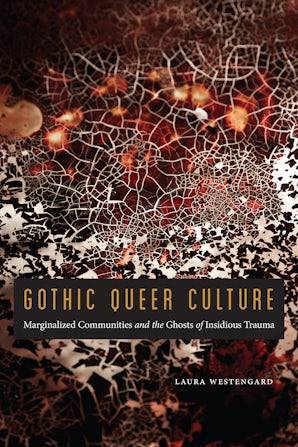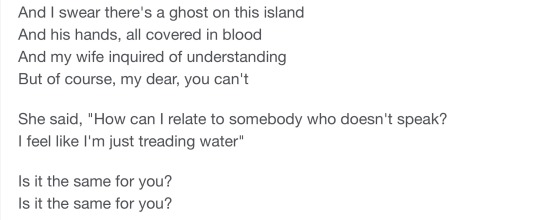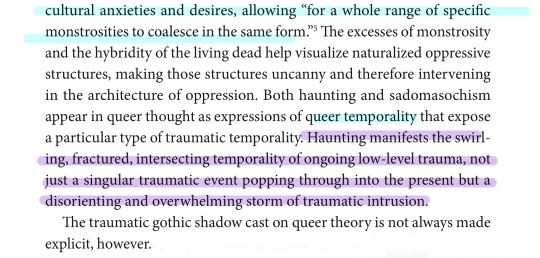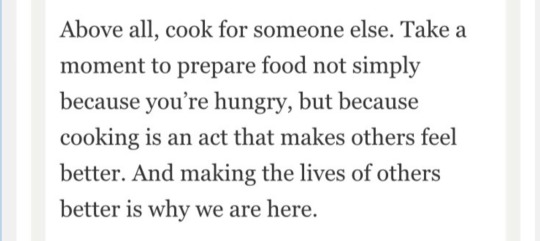#Laura Westengard
Text
University of Nebraska professor Laura Westengard wrote the book Gothic Queer Culture, a book about the correlation between queerness and gothicism.

You can purchase it for yourself on the University of Nebraska website. You can get forty percent off with the discount code 6AF19.
#Gothic Queer Culture#Laura Westengard#University of Nebraska#queer culture#gothic subculture#gothic#gothicism#gothgoth#books#goth books#discount code#World Goth Day#goth#goth subculture#queer#lgbt
131 notes
·
View notes
Text










i feel like it’s potentially relevant i keep track of these all in a discord channel called nettle spiralling. family portrait of nettle nolastname
@july-19th-club / my nieces is probably the reincarnation of shirley jackson, cj hauser with notes / all about love, bell hooks / where angels fear to tread, e m forster / antichrist, the 1975 / elisabeth hewer / haunted epistemologies, laura westengard / letters to a young poet, rainer maria rilke / sam sifton / the anthropocene reviewed, john green
[Image Description: Ten pictures of text.
1: “simply cannot resist what i call the little mermaid or the tin man or the pinocchio plot, the one about a character who is either inhuman or human but outside in some way, constantly searching for whatever it is that they consider to be the quintessential proof of humanity, preoccupied by it so deeply that they fail to realise the proof is in the act and fact of the search itself”
2: “”What does it mean for the structure of your life to feel menacing? To be imprisoned within it? To feel like it might kill you?”
Haunting is an act of care, care is an act of haunting. Haunting is formed between the trauma, mothers inflict on their daughters.”
3: “We can never go back. I know that now. We can go for-ward. We can find the love our hearts long for, but not until we let go grief about the love we lost long ago, when we were little and had no voice to speak the heart’s longing.” The first three sentences are highlighted in red.”
4: “I seem fated to pass through the world without colliding with it or moving it - and I’m sure I can’t tell you whether the fate’s good or evil. I don’t die - I don’t fall in love. And if other people die or fall in love they always do it when I’m just not there.”
5: “And I swear there's a ghost on this island / And his hands, all covered in blood / And my wife inquired of understanding / But of course, my dear, you can't
She said, How can I relate to somebody who doesn't speak?/ I feel like I'm just treading water
Is it the same for you? / Is it the same for you?”
6: “I want to be eaten alive. I want / to feel wanted.”
7: “cultural anxieties and desires, allowing”for a whole range of specific monstrosities to coalesce in the same form.” The excesses of monstrosity and the hybridity of the living dead help visualize naturalized oppressive structures, making those structures uncanny and therefore intervening in the architecture of oppression. Both haunting and sadomasochism appear in queer thought as expressions of queer temporality that expose a particular type of traumatic temporality. Haunting manifests the swirl-ing, fractured, intersecting temporality of ongoing low-level trauma, not just a single event popping through into the present but a disorienting and overwhelming storm of traumatic intrusion.
The traumatic gothic shadow cast on queer theory is not always made explicit however.” The initial sentence fragment and queer temporality are highlighted in blue. The penultimate sentence is highlighted in purple.
8: “You must realise that something is happening to you, that life has not forgotten you, that it holds you in its hands and will not let you fall.”
9: “Above all, cook for someone else. Take a moment to prepare food not simply because you’re hungry, but because cooking is an act that makes others feel better. And making the lives of others better is why we are here.”
10: A photo of a page of a book, some lines are highlighted in yellow throughout. “would like that, to show it your belly. There’s something deep within me, something intensely fragile, that is terrified of turning itself to the world.
I’m scared to even write this down, because I worry that having confessed this fragility, you now know where to punch. I know that if I’m hit where I am earnest, I will never recover.
It can sometimes feel like loving the beauty that surrounds us is somehow disrespectful to the many horrors that also surround us. But mostly, I think I’m just scared that if I show the world my belly it will devour me. And so I wear the armor of cynicism, and hide behind the great walls of irony, and only glimpse beauty with my back turned to it, through the Claude glass.
But I want to be earnest, even if it’s embarrassing.”
End ID.]
#litstack#web weaving#quotes#personal#c:lensa#nettle :)#yes I am using nettle feelings to make you all read a chunk of one of my favourite papers#haunted epistemology my absolute beloved
318 notes
·
View notes
Note
Sorry if this is too broad question but could you share some recs of books/articles/readings about fairytales and/or folkloristics? It's one of those subjects I've always been interested in but I'm never sure how to find good readings for it 😅 On a similar note, do you happen to have a goodreads/storygraph acc and would you be ok with strangers following you? Totally fine if the answer is no btw! Hope you have a good day!
well let me start by saying @obeetlebeetle is by far the better person to put this question to and i would love to hear his recs if he feels like adding any : )
so far i have read the case of peter pan, or the impossibility of children’s fiction by jacqueline rose and i'm in the middle of off with their heads: fairytales and the culture of childhood by maria tatar. i tried to read princess floralinda and the forty flight tower but it was really doing NOTHING for me sorry tzmuir nation.. feel free to tell me if the ending makes it worth it or smth
on my pile: phillip pullman's edition of the grimm fairytales, fairytales by robert walser, the book of goose by yiyun li, morphology of the folktale, and the classic fairytales ed. maria tatar.
i am also getting a lot out of gothic studies which i think dovetails nicely with fairytale analysis; i recently read and enjoyed gothic incest by jenny diplacidi and the contested castle by kate ferguson ellis is next on my list. also upcoming: skin shows / gothic horror and the technology of monsters by jack halberstam, gothic queer culture by laura westengard, and queer gothic by george haggerty.
finally, i have been going back to reread authors whose plots and prose give me fairytale vibes; this is not really based on anything besides general themes of horror, domestic terror, and the violence/beauty nexus, but ive gotten a lot out of rereads of the bluest eye and the handmaid's tale and am planning to reread we have always lived in the castle next. i also want to read deerskin by robin mckinley!
additionally you might find things i've forgotten under #neverafter and/or #pure heroine
23 notes
·
View notes
Photo

Gothic Queer Culture: Marginalized Communities and the Ghosts of Insidious Trauma (Expanding Frontiers: Interdisciplinary Approaches to Studies of Women, Gender, and Sexuality), by Laura Westengard, University of Nebraska Press, 2019. Info: nebraskapress.unl.edu.
In Gothic Queer Culture, Laura Westengard proposes that contemporary U.S. queer culture is gothic at its core. Using interdisciplinary cultural studies to examine the gothicism in queer art, literature, and thought—including ghosts embedded in queer theory, shadowy crypts in lesbian pulp fiction, monstrosity and cannibalism in AIDS poetry, and sadomasochism in queer performance—Westengard argues that during the twentieth and twenty-first centuries a queer culture has emerged that challenges and responds to traumatic marginalization by creating a distinctly gothic aesthetic. Gothic Queer Culture examines the material effects of marginalization, exclusion, and violence and explains why discourse around the complexities of genders and sexualities repeatedly returns to the gothic. Westengard places this queer knowledge production within a larger framework of gothic queer culture, which inherently includes theoretical texts, art, literature, performance, and popular culture. By analyzing queer knowledge production alongside other forms of queer culture, Gothic Queer Culture enters into the most current conversations on the state of gender and sexuality, especially debates surrounding negativity, anti-relationalism, assimilation, and neoliberalism. It provides a framework for understanding these debates in the context of a distinctly gothic cultural mode that acknowledges violence and insidious trauma, depathologizes the association between trauma and queerness, and offers a rich counterhegemonic cultural aesthetic through the circulation of gothic tropes.
Contents:
List of Illustrations
Preface
Acknowledgments
Introduction: Queer Cultures and Insidious Trauma
1. Haunted Epistemologies: Gothic Queer Theory
2. Live Burial: Lesbian Pulp and the “Containment Crypt”
3. Monstrosity: Melancholia, Cannibalism, and HIV/AIDS
4. Sadomasochism: Strategic Discomfort in Trans* and Queer of Color Performance Art
Conclusion: The Challenges of Neoliberalism
Notes
Bibliography
Index
14 notes
·
View notes
Text
https://www.dailydot.com/irl/trans-sex-fantasy-porn-queer-monsters/?amp&__twitter_impression=true
This is a great article tbh, I love reclaiming monstereous imagery
2 notes
·
View notes